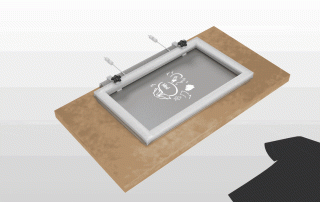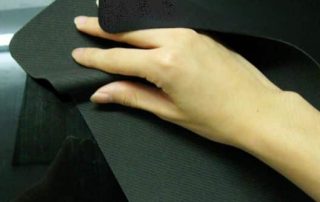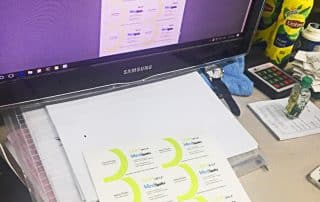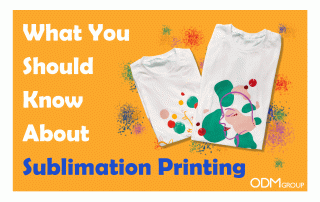Silicone screen printing has revolutionized the way promotional products are customized. Unlike traditional printing techniques, silicone screen printing offers exceptional durability and flexibility.
From intricate designs and gradients to bold and vibrant colours, this printing method brings even the most complex artwork to life. Whether it’s imprinting logos, slogans, or custom designs, silicone screen printing ensures that promotional products become captivating visual representations of a brand’s identity.
Understanding Silicone Screen Printing
Silicone screen printing is a printing technique that utilizes specialized silicone ink to transfer designs onto various surfaces. The process involves creating a stencil on a screen mesh, with the silicone ink being forced through the open areas of the stencil onto the substrate.
This method allows for precise and detailed prints with exceptional durability and longevity.
The use of silicone inks ensures that designs remain vibrant and intact even after repeated use and exposure to various environmental conditions. This longevity translates into increased brand visibility and customer engagement, making silicone screen printing a powerful tool for businesses aiming to leave a lasting impression.
Unmatched Versatility
One of the most remarkable aspects of silicone screen printing is its compatibility with a wide range of substrates. From textiles and plastics to glass and metals, silicone screen printing can transform almost any surface into a canvas for creativity.
Here are some examples of products that can be printed using silicone screen printing:
1. Apparel and Textiles
T-shirts, hoodies, hats, socks, swimwear, activewear, and other clothing items can be printed with silicone screen printing. The ink adheres well to fabrics, providing vibrant and long-lasting designs.
2. Accessories
Silicone screen printing can be used to enhance accessories such as bags, backpacks, wallets, belts, scarves, gloves, and headbands. It adds a unique and eye-catching element to these items.
3. Electronics
Silicone screen printing is commonly used in the electronics industry to print graphics, icons, and labels on devices such as smartphones, tablets, laptops, keyboards, remote controls, and wearable technology.
4. Automotive
The interior and exterior components of vehicles can be printed using silicone screen printing. This includes dashboard panels, control buttons, instrument clusters, knobs, trims, and logos.
5. Promotional Items
Silicone screen printing is an excellent choice for promotional products like pens, keychains, drinkware (cups, bottles), phone cases, and USB drives. It allows for precise branding and customization.
6. Glassware
Glass products such as bottles, jars, vases, and glass containers can be printed with silicone screen printing. The ink adheres well to glass surfaces and provides a durable and visually appealing finish.
7. Packaging
Silicone screen printing can be applied to various packaging materials, including paperboard boxes, flexible packaging (bags, pouches), labels, and blister packs. It helps create attractive and informative packaging designs.
8. Industrial Products
Certain industrial products benefit from silicone screen printing, such as control panels, membranes, safety equipment, machinery components, and product identification labels.
9. Sporting Goods
Silicone screen printing can enhance sporting goods such as sports equipment (rackets, balls), helmets, protective gear, athletic shoes, and jerseys, adding branding elements and decorative designs.
Expect Vibrant and Eye-Catching Results
When it comes to vibrant and eye-catching results, silicone screen printing truly shines. The specialized silicone inks used in this process allow for a broad spectrum of colours and effects, from bold and vibrant hues to subtle and delicate shades.
Additionally, the versatility of silicone ink enables the creation of textured, embossed, and three-dimensional prints, adding a whole new dimension to the visual impact of the designs.
The Process Unveiled
In this intriguing process, the boundaries of traditional printing techniques are pushed, offering a wide array of possibilities for designers and manufacturers alike.
Whether you’re looking to enhance your product’s branding, add eye-catching designs to promotional items, or create stunning graphics on various surfaces, silicone screen printing offers a cutting-edge solution.
What Are the Materials Needed?
-
Screen Mesh
In silicone screen printing, the screen mesh plays a crucial role. It is typically made of a fine, tightly woven fabric, such as polyester or nylon. The mesh is stretched tightly over a frame, creating a taut surface for the stencil application.
The mesh’s fineness and integrity ensure precise ink transfer through the open areas of the stencil while blocking the ink in areas covered by the stencil. The screen mesh’s quality and tension directly impact the sharpness and clarity of the final print.
-
Rubber Squeegee
A rubber squeegee is an essential tool in silicone screen printing. It consists of a handle and a flexible rubber blade. The squeegee is used to pressure and drag the silicone ink across the screen stencil, forcing the ink through the open areas onto the substrate.
The rubber blade’s flexibility allows for even ink distribution and ensures proper coverage. The squeegee’s size and hardness can be adjusted based on the design, substrate, and desired ink deposit.
-
Stencil Material
The stencil material acts as a barrier, blocking the silicone ink in specific areas and allowing it to pass through in others. The stencil can be created using various materials, including photosensitive emulsion-coated screens, films, or pre-made stencil sheets.
It is prepared to accurately reproduce the desired design and provide clean, well-defined edges for the printed image. Choosing a stencil material that can withstand the ink application process without breaking down or distorting the design is essential.
-
Artwork Design
In silicone screen printing, the artwork design refers to the visual image or graphic that is to be printed onto the substrate using silicone ink.
The artwork design can be created using various methods, including digital design software, hand-drawn illustrations, or a combination of both. The design can range from simple shapes and patterns to intricate illustrations or detailed logos.
-
Silicone Ink
Silicone ink is specially formulated for silicone screen printing. It comprises silicone polymers, pigments, additives, and curing agents. Furthermore, this ink has unique properties that make it ideal for this printing technique.
It is flexible, durable, and provides excellent adhesion to various substrates. Silicone ink is available in a wide range of colours and can be transparent or opaque.
It offers excellent resistance to environmental factors, chemicals, and extreme conditions, ensuring the longevity and vibrancy of the printed image.
-
Substrate
The substrate refers to the material or surface onto which the silicone ink is applied. It can vary depending on the intended application, including textiles, plastics, glass, metals, paperboard, etc.
Silicone screen printing allows for printing on a diverse range of substrates due to its exceptional adhesion and versatility.
It should be clean and properly prepared to ensure optimal ink adhesion and durability. The choice of substrate influences the printed product’s final appearance, texture, and functionality.
-
Drying Machine
A drying machine, also known as a curing oven or heat tunnel, accelerates silicone ink’s curing process. After the ink is applied to the substrate, it must be cured to achieve its durable and long-lasting properties.
The drying machine provides controlled heat and airflow to expedite the curing process. It ensures that the ink reaches the desired temperature and cures evenly throughout, enhancing its durability, adhesion, and resistance to wear and tear.
These machines are available in various sizes and configurations to accommodate different printing setups and production requirements.
The Step-by-Step Process
1. Prepare the Artwork
The first step in silicone screen printing is to prepare the artwork. This involves selecting or creating a design that you want to print. You can either choose from existing designs or unleash your creativity to come up with a unique design that reflects your style or aligns with your project’s objectives.
Once you have your design, it’s essential to resize and adjust it to fit the desired print area. This ensures that the design will be accurately represented when transferred onto the substrate.
2. Create the Stencil
Creating a stencil is a crucial part of the silicone screen printing process.
- To begin, place the stencil material on top of a clean mesh screen. It’s important to ensure that the mesh screen is free from any dust, debris, or previous ink residue that could affect the stencil’s quality. Secure the stencil material tightly using clamps or a stretching machine to ensure that it remains in place during the printing process.
- Next, expose the screen to UV light according to the instructions provided by the stencil material manufacturer. The UV light will cure the photosensitive emulsion on the screen, creating a hardened stencil.
- After the exposure, rinse the screen with water to remove any uncured emulsion, revealing the stencil with the desired design.
3. Mix and Apply Silicone Ink
Thoroughly mixing the silicone ink is essential to achieve consistent colour and texture throughout your print. Make sure to mix the ink according to the manufacturer’s instructions, using a spatula or mixing tool to ensure a thorough blend.
- Once the ink is properly mixed, place the substrate on a flat surface or printing press. Position the prepared screen with the stencil over the substrate, ensuring that the stencil aligns with the desired print location.
- To begin applying the ink, pour a line of silicone ink onto one end of the stencil. Hold the squeegee at a 45-degree angle and apply even pressure as you drag the ink across the stencil, filling the open areas with ink.
- Repeat this process a few times to ensure proper ink coverage and a vibrant print.
4. Curing
After applying the ink, the substrate needs to go through a curing process to ensure the ink dries and sets properly.
- Transfer the printed substrate to a drying machine or heat tunnel, which provides controlled heat and airflow.
- Set the machine to the recommended curing temperature and time for the specific silicone ink you are using. It’s crucial to follow the manufacturer’s instructions to ensure optimal curing results.
- Allow the substrate to remain in the drying machine until the silicone ink is completely dry and fully set. This ensures that the print becomes durable, long-lasting, and resistant to wear and tear.
Troubleshooting Tips
During the silicone screen printing process, you may encounter some common issues like smudging, bleeding, or clogging. To address these problems, you can make a few adjustments.
- If you notice smudging or bleeding, you may need to adjust the pressure or angle of the squeegee. Experiment with different levels of pressure and find the sweet spot that allows for a clean and crisp print.
- If you experience clogging, check the ink consistency and make sure it’s not too thick. Adjust the ink consistency if necessary to ensure smooth ink flow. Additionally, ensure that the stencil is securely attached to the screen to prevent any leaks or smudges during the printing process.
What Are the Limitations of Silicone Screen Printing?
While silicone screen printing offers numerous advantages, it also has some limitations:
Want to wow with your promotional products? Unleash your creativity and explore our ultimate list of decoration methods!
Silicone Screen Printing FAQs
What is silicone screen printing?
Silicone screen printing is a specialized printing technique used to apply silicone-based inks onto various surfaces, such as fabric, plastic, or glass. It involves transferring a design or pattern onto the desired material using a screen, which allows for precise and detailed printing.
What are the advantages of silicone screen printing?
Silicone screen printing offers several advantages, including durability, flexibility, softness, high opacity and heat resistance.
What types of materials can be printed using silicone screen printing?
Silicone screen printing can be used on a wide range of materials, including textiles (such as cotton, polyester, and nylon), plastics (such as PVC and polyurethane), glass, metal, and some coated surfaces. It is particularly popular for printing on fabrics used in sportswear, swimwear, accessories, and promotional items.
How does silicone screen printing work?
Silicone screen printing involves several steps including design preparation, screen preparation, ink application, curing/ baking and finishing.
What are the limitations of silicone screen printing?
While silicone screen printing offers numerous advantages, it also has some limitations including limited color options, longer curing times, cost and complex designs.
Harness Our Creativity!
Silicone screen printing has proven to be a highly effective and versatile printing method for promotional products. This innovative technology offers a myriad of benefits, including durability, vibrancy, and adaptability, which make it an ideal choice for businesses looking to create eye-catching and long-lasting promotional items.
Furthermore, the ability to print on a wide range of materials, from textiles to plastics, ensures that companies can create a diverse selection of products to cater to their target audience’s preferences.
We at the ODM Group can help you through it all! We’re a promotional product company that specialises in the customisation of custom merchandise and promotional displays.
We have our own creative team, Mindsparkz, to lend a hand every step of the way, from brainstorming sessions to production. Contact us today!









